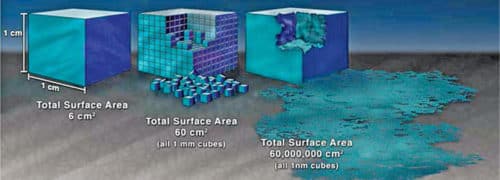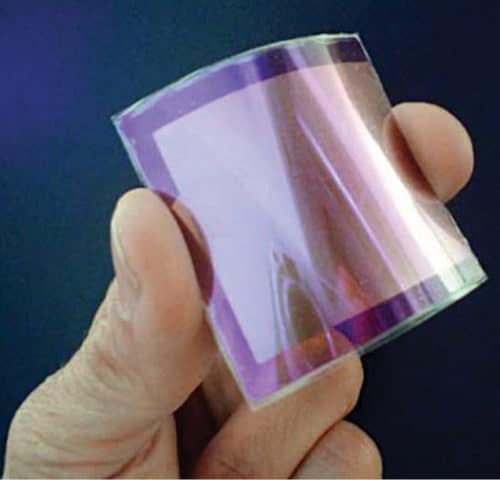In simple terms, nanotechnology is the part of science that deals with the control of matter with dimensions smaller than 100 nanometres, and can go down to atomic and molecular scales.
The study and manipulation of matter, particles and structures on the nanometer scale is referred to as nanoscience. Nanotechnology is the application of nanoscience that deals with the use of nanomaterials and nano-sized components in various products. It provides the ability to design custom-made materials and products with new and enhanced properties. It has a wide range of applications in nanoelectronic components, medicines and sensors, and interfaces between electronics and biological systems.
Scientists and engineers are deliberately making nanomaterials to take advantage of their enhanced properties, such as lighter weight, higher strength, increased control of light spectrum and greater chemical reactivity. Majority of biological processes occur at the nanoscale, including essential molecular reactions within the human body and components of foods. Dealing at the nanoscale enables scientists to utilise the unique physical, mechanical, chemical and optical properties of materials.
Need for development of nanomaterials
Nanomaterials have a high surface-to-volume ratio than large-scale materials of similar masses. As surface area increases, a greater amount of the material can come into contact, thus affecting reactivity. Greater surface area and improved reactivity help create better catalysts. Catalysis by engineered nanostructured materials has impacted the catalyst market globally. For example, a catalytic converter in a car reduces the toxicity of the engine’s fumes.
Nanoengineered batteries, fuel cells and catalysts produce cleaner and safer modes of storing energy. A large surface area makes nanomaterials suitable for water treatment and desalination. It supports applications ranging from drug delivery to clothing insulation. Using nanotechnology, materials can effectively be made stronger, lighter, more durable, more reactive or better electrical conductors, among many other traits.
Poonam Sharma, research fellow at The Energy and Resources Institute (TERI), comments, “The need to develop nanoparticles is different based on their applications, as we are utilising nano in various sectors. An example is micro-electro-mechanical systems (MEMS) wherein we shifted to nanoelectromechanical systems (NEMS), which helps in enhancements in properties and performance. Plenty of instruments are utilised to study nanoparticles, and it all depends on the kind of property you are looking for and the kind of nanoparticle it is.”
Nanomaterials of different dimensions
Nanomaterials can be broadly classified as one-dimensional (1D), two-dimensional (2D) and three-dimensional (3D). Nanowire nanomaterials are examples of 1D nanomaterials, which improve both energy capacity and charge rate in rechargeable batteries. Activated graphene makes superior supercapacitors for energy storage.
2D materials are made up of layers of crystal, for example, molybdenum oxides. These have unique properties that encourage free flow of electrons at ultra-high speeds. Nanotubes and nanowires are 2D.
Fullerenes, dendrimers and quantum dots are 3D nanoparticles.
Carbon nanotubes (CNTs) are mechanically extremely strong, flexible and can conduct electricity. These have a range of potential applications in reinforced composites, sensors, nanoelectronics and display devices.
Inorganic nanotubes and inorganic fullerene-like materials based on layered compounds such as molybdenum disulphide have excellent lubricating properties, resistance to shockwave impact, catalytic reactivity, and high capacity for hydrogen and lithium storage.
Oxide-based nanotubes such as titanium dioxide are used for catalysis, photo-catalysis and energy storage.
Nanowires have potential applications in high-density data storage, either as magnetic read heads or as patterned storage media, and electronic and opto-electronic nanodevices for metallic interconnects of quantum devices and nanodevices.
Areas benefitting through nanotechnology
Nanotechnology is helping improve and revolutionise many technologies and industry sectors such as information technology, medicine, transportation, energy, food safety, electronics and environmental science, among others. Many everyday commercial products currently in the market and in daily use rely on nanoscale materials and processes.
Everyday materials and processes
Nanomaterials used for surface treatment helps in designing nanoscale films for eyeglasses, computer and camera displays, windows and other surfaces. These can make them water- and residue-repellent, anti-reflective, self-cleaning, resistant to ultraviolet (UV) or infrared (IR) light, anti-microbial, scratch-resistant and electrically-conductive. Nanostructured ceramic coatings have much greater toughness than conventional wear-resistant coatings.

Nanomaterials make superior household products such as stain removers, environmental sensors, air purifiers and filters, anti-bacterial cleansers, sealing products, self-cleaning house paints that resist dirt and marks, and so on. Their use in daily materials such as baseball bats, tennis rackets and helmets make these lightweight, stiff, durable and resilient.
Applications in automotives
Lightweight structures for vehicles, aeroplanes, boats and spacecraft could lead to significant fuel savings. CNTs are a good combination of light weight and conductivity, which makes these ideal for next-generation air vehicles.
Bioengineered enzymes have been developed to convert cellulose into ethanol for fuel. Nanomaterials for automotive products are useful in high-power rechargeable battery systems and tyres with lower rolling resistance.
Nanotechnology-enabled lubricants and engine oils significantly reduce wear and tear. This has significantly extended the lifetimes of moving parts in everything from power tools to industrial machinery.
Electronics and IT applications
Nanotechnology has greatly contributed to major advances in computing and electronics, leading to faster, smaller and more portable systems that can manage and store larger amounts of information. These continuously-evolving applications include transistors and basic switches that have enabled modern computing to become smaller through nanotechnology.
Entire memory can be stored on a single tiny chip using these smaller and faster transistors. Ultra-high-definition displays and televisions utilise quantum dots to produce more vibrant colours, which are more energy-efficient.
Small, flat, flexible, lightweight, non-brittle and highly-efficient electronics open the door to countless smart products.
Small sensors using silver nanowires are useful in robotics and prosthetics. Nanowire sensors can measure strain and pressure, and are flexible enough to work over a wide range of motion required by prosthetics.
Nanomaterials are used to design washable, durable and smart fabrics equipped with sensors and electronics, with capabilities for health or activity monitoring, solar energy capture and energy harvesting through movement.
Other computing and electronic products include ultra-responsive hearing aids, conductive inks for printed electronics for RFID/smart cards/smart packaging and flexible displays for e-book readers.
Medical and health applications
Better imaging and diagnostic tools enabled by nanotechnology help in earlier diagnosis and achieving better therapeutic success rates. Various nanomaterials have been developed to monitor glucose levels in people with diabetes, to block malaria parasites from spreading to new red blood cells, to purify blood as an alternative to dialysis and to stimulate immune responses.
Some other uses of nanoparticles in biology and medicine are gene delivery systems in gene therapy and biological detection of diseases. One advantage of using nanoparticles as a drug delivery system is that, targeted drugs may be developed to increase drug therapeutic efficacy and reduce side effects.
Environmental applications
Nano solar cells can convert sunlight into electricity more efficiently. These are cheaper to manufacture and easier to install since these can use print-like manufacturing processes and can be made to be flexible.
Nanotechnology-enabled sensors and solutions can now detect and identify chemical or biological agents in the air and soil with much higher sensitivity.
Nanoparticles are being developed to clean industrial water pollutants in groundwater through chemical reactions that render the pollutants harmless.
A nanofabric paper towel woven from tiny wires of potassium-manganese-oxide has been developed. It can absorb 20 times its weight in oil for cleanup applications. Magnetic water-repellent nanoparticles in oil spills use magnets to mechanically remove the oil from the water.
Steps involved in the research of nanotechnology
Jonny Dhiman, research analyst, Promax Legal Solution, says, “Research of nanotechnology is based on the synthesis or analysis of nanoparticles. There are many steps involved in the research of nanotechnology. Two of these are top-down approach and bottom-up approach. In the first, bulk particles are converted into nanoparticles to analyse and study their properties.
“In bottom-up approach, nanoparticles are combined together to analyse the changes in their properties due to structural reformation.
“Steps involved in nanotechnology start with the preparation of materials using techniques so that these are in nano-regime. Then, characterisation of prepared materials is done using various characterisation techniques. Finally, analysis of various physical properties for prepared samples or materials is done.”
It is well-known from colloid science that nanoparticles can form aggregates, especially when these are kept as a powder under dry conditions. This aggregation can create difficulties while testing the toxicity of nanoparticles.
Instruments required to study nanoparticles
Atomic force microscopy (AFM) is used for visualising, imaging, measuring and manipulating objects in nanometre scale. Its resolution is of the order of fractions of a nanometre. It has a sharp tip cantilever that is used to scan the surface of the material.
AFM is used to measure many parameters. Some common measurements that are taken are Van der Waals force, chemical bonding, capillary forces and mechanical contact force. Many other parameters can also be measured if additional probes are fitted to the device. This is also known as scanning force microscopy.
A scanning tunnelling microscope is used for imaging surfaces at atomic level. It can be used in different modes like air, water and high vacuum. It can also be used in very low and high temperatures. A difference in voltage is applied when the tip of the device is brought near the material. This causes the electrons to move through the empty space created between them.
Dhiman adds, “Structural properties of nanoparticles can be studied by x-ray diffraction, morphology by scanning electron microscopy (SEM) or by field emission scanning electron microscope (FESEM), defects by photoluminescence (PL) analysis or by using UV Raman spectroscopy.”
Other equipment used in the research of nanoparticles are nanocomposite deposition systems, nano manipulators, nanopositioning systems, nanolithography systems and more.

Available standards
There are various groups involved in developing nanotechnology standards. Some of the leading nanotechnology standards-setting organisations and committees are:
- ISO (or, International Standardization Organization) Technical Committee 229 on Nanotechnologies
- ASTM (or, American Society for Testing and Materials) International Committee E56 Nanotechnology
- IEEE (or, Institute of Electrical and Electronics Engineers) Nanotechnology Council
- International Electrotechnical Commission Technical Committee 113; it develops nanotechnology standards for electrical and electronic products and systems
Some examples of documentary standards available for nanomaterials are: - ASTM E2996-15: Guide for workforce education in nanotechnology health and safety
- ASTM E2490-09(2015): Standard test method for analysis of hemolytic properties of nanoparticles
- ASTM E2524-08(2013): Standard test method for analysis of hemolytic properties of nanoparticles
- ASTM E2909-13: Standard file format for the submission and exchange of data on nanomaterials
- ISO/TR 13014:2012: Physico-chemical characterisation of engineered nanoscale materials for toxicologic assessment
To sum up
Nanotechnology is an emerging field of science and technology. It is a field of research and innovation concerned with building materials and devices on atomic scale. Ordinary rules of physics and chemistry at such scales no longer apply. Basically, here physics leaves its classical realm and enters a new world of quantum mechanics.
The scientific community, policymakers, apex bodies and funding agencies are continuously striving to progress in various areas of nanoscience and nanotechnology. In the last two decades, India has achieved many milestones in the areas of nanoelectronics, nanomaterials and nano-biotechnology, and many are yet to be achieved.













